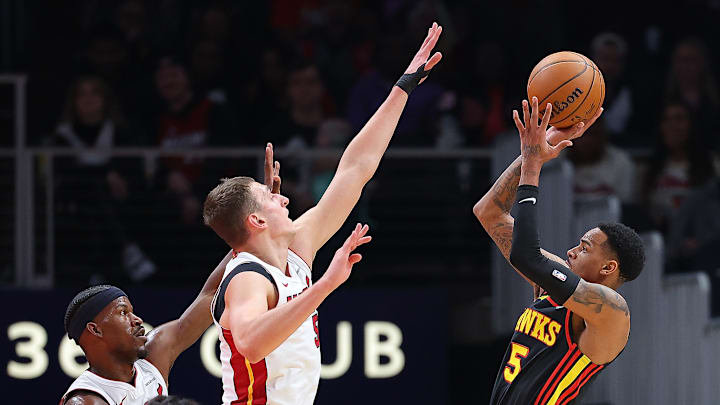Three observations from the Miami Heat’s 117-111 double-overtime win over the Atlanta Hawks on Tuesday.
1. Bam Adebayo’s corner 3s
Twelve of Bam Adebayo’s 14 made 3s this season have been from the top of the arc. It makes sense. Adebayo spends a lot of time there initiating screens and dribble handoffs and things like that. It’s a natural place for him to pull up in rhythm when defenses ignore him.
He’s made only two corner 3s all season, including one early in Tuesday night’s win in Atlanta.
The action itself isn’t anything new. The Heat generate a ton of corner 3s off these exact sort of baseline drives (usually it’s Jimmy Butler driving and kicking out to a shooter). Only here, some of the roles have been recast. Butler is way above the break (he drifts out of the picture), dragging his defender as far away from the paint as he can. Nikola Jovic, a 41% 3-point shooter, is spaced out above the break. Tyler Herro is occupying Dejounte Murray on the opposite wing.
Adebayo rotates into the corner as Caleb Martin drives into the open paint. Clint Capela leaves Adebayo to contest Martin at the basket and Martin kicks out to the teammate in front of him. Adebayo drains the wide-open corner 3.
The Heat don’t draw this up for Adebayo often – Again, he’s only made two corner 3s all season. They’d rather someone like Jovic, Duncan Robinson or Haywood Highsmith shoot these – but having Adebayo in the corner spot rather than in the dunker creates more space for Martin or anyone else to drive.
Adebayo has been practicing his corner 3s for years, so much so that Erik Spoelstra recently asked him to put more work into shooting from the top of the arc because those shots are more readily available in Miami’s offense. He’s not wrong, but it wouldn’t be such a bad idea to throw in some of these sets more, either.
2. Nikola Jovic’s defense isn’t a weakness
There was a time not long ago when Nikola Jovic struggled to get on the floor because of his defense. That has changed.
Jovic has started his last 23 games for the Heat and has been leveling up like a young Pokemon thrown into the Elite Four. Jovic got on the floor because of his size, spacing and ability to push the pace, but he’d play a token stint at the beginning of each half before Miami inevitably shifted small.
But Jovic has closed the last two high-stakes games for the Heat, including Sunday’s must-win in Indiana. His 39 minutes in Tuesday’s double-overtime affair are a career-high. If that’s not a sign that Spoelstra trusts the 20-year-old power forward, then nothing is. A big reason for this trust is Jovic’s improvement on defense – particularly when he gets switched onto a ball-handler. He hasn’t been the weakness many assume he’d be.
Here’s a mashup of Jovic getting switched onto Dejounte Murray and defending Atlanta’s best-available offensive player in space.
A lot of talk about Jovic on offense last night but Hawks were putting him in actions to get Dejounte on him & he held his own
— John Jablonka (@JohnJablonka_) April 10, 2024
I don't think Dejounte scored at all on any possesions
Him being serviceable on switches is big for different lineups they run pic.twitter.com/bfMART5yT8
The Heat have been switching more on defense lately, and a reason for that is Jovic’s ability to play the scheme. Spoelstra was limited to playing zone with Jovic in the game as recently as this season. Now Jovic is routinely holding his own when switched onto ball-handlers on the perimeter. This is a big development and a reason why Jovic has earned a spot in Spoelstra’s playoff rotation.
3. Miami's crunch-time two-man game
Miami’s crunch-time offense wasn’t inspiring Tuesday night, but there is something to glean from how the Heat approached two possessions at the end of regulation and the first overtime period.
Here’s the first one, with 17.1 seconds left in a tie game. Caleb Martin sets a screen for Jimmy Butler, Tyler Herro comes up from the opposite corner to get the ball and the two flow into a dribble handoff.
It doesn’t work in part because Bogdan Bogdanovic fights over Martin’s screen and forces Butler to go wide, which pushes the action to a tough place on the sideline. But we’re not focused on the result here. Just the process.
Not great.
— Wes Goldberg (@wcgoldberg) April 10, 2024
Butler did call Herro up for the screen but looked like Bogdanovic screwed up Miami's action by fighting through the screen and taking away Butler's space. Everything went to shit after. pic.twitter.com/OuFnrZhViu
Later, in the final seconds of the first overtime period, the Heat go to a similar action with Butler getting a screen and looking for Herro lifting from the corner. There’s a mishap on the pass leading to a turnover but, again, process.
Jimmy Butler is not happy (his reaction is at the very end of this clip) pic.twitter.com/EJTwFrCRAT
— Wes Goldberg (@wcgoldberg) April 10, 2024
What we can take from these two plays is that Miami’s crunch-time offense will likely involve both Butler and Herro. Butler as the decision-maker, Herro as the shot-taker. If the drive had been available, perhaps Butler gets to the rim and draws a foul or creates more space with a kick-out to Herro. That’s how it should work, anyway. Credit to Atlanta’s defense for snuffing it out, but I do think the premise is sound. The Heat just need to iron out the wrinkles.
